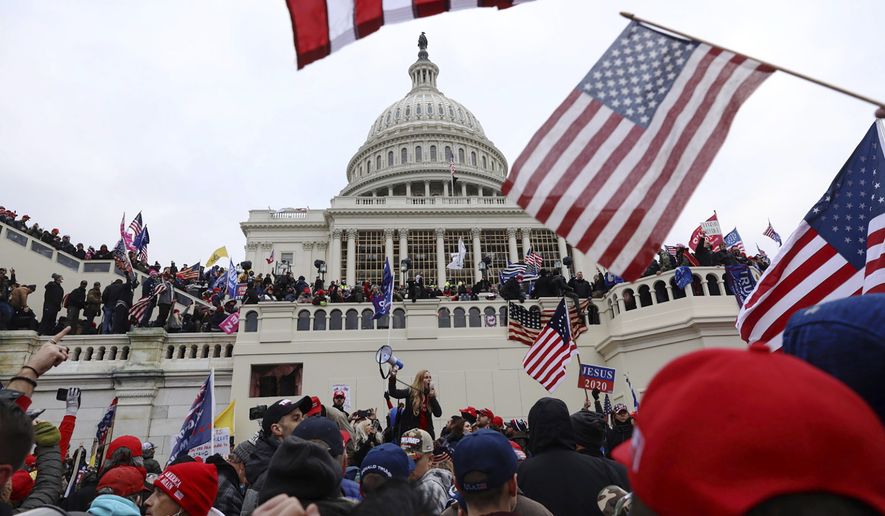The number of U.S. Capitol invaders charged with crimes has topped 400, Justice Department records show, and in a recent case the FBI disclosed new twists in identifying and ensnaring a suspect.
A Washington Times review of scores of law enforcement affidavits justifying an arrest show this pattern: Agents examine thousands of videos and photos taken inside the Capitol on Jan. 6. In old-school detective work, officers pick out a target and compare Capitol images to online posts from that day or previous days based on tips from the invaders’ friends, co-workers and even family.
To seal the deal, FBI agents openly approach the suspect in a phone call or home visit. The targets in many cases readily admit to their actions. It is difficult to deny wronging when caught on camera.
In the case of Stephen C. Randolph of Kentucky, agents went more high-tech — and deceptive — according to documents filed last week in U.S. District Court in Washington, where all defendants in the Capitol breach face prosecution. The Justice Department’s Capitol Breach Cases website now totals 423 defendants.
FBI agents in Kentucky turned to computerized facial recognition technology to nail Mr. Randolph’s identification and went undercover to try to obtain incriminating statements, the affidavit discloses.
Mr. Randolph was one of about 800 Trump supporters who breached the Capitol on Jan. 6 as part of outgoing President Trump’s “Stop the Steal” movement. Mr. Trump wanted to pressure Vice President Mike Pence to send the congressional joint session’s Electoral College votes back to battleground states, where legislatures could reelect him. Mr. Pence, the chamber’s presiding officer, refused, and Congress certified Joseph R. Biden as the winner.
“It is my considered judgment that my oath to support and defend the Constitution constrains me from claiming unilateral authority to determine which electoral votes should be counted and which should not,” Mr. Pence said.
For Mr. Randolph, the FBI first put his photo — No. 168, unmasked in a gray beanie — along with 10 other protesters on one of its “seeking information” public lists.
“Assault on Federal Officers and Violence at the United States Capitol,” the list was headlined.
On Feb. 2, Mr. Randolph’s photograph popped up on a Twitter account, @SeditionHunters, which showed him in a black jacket and gray turtleneck. Headline: “Do You Know This Person?”
In addition, an Instagram screen shot “shows the subject physically confronting [U.S. Capitol Police] officers and specifically shows the subject falling to the ground and his grey toboggan is beginning to come off his head,” the affidavit states. The scene also was found in a YouTube video.
FBI agents determined that all images were of the same person.
Next came technology. “Using an open source facial comparison tool, known to provide reliable results in the past, the FBI submitted photograph [in the FBI bulletin] due to it being a clear, straight-on photograph of subject,” the affidavit states.
Agents got a match.
The app took them to an Instagram page under the account of Mr. Randolph’s girlfriend. There they found him in numerous photos. In one group photo, he is wearing the same gray beanie seen in Capitol images. He is identified as “Stephen.”
“A check of Kentucky Driver’s License records for STEPHEN CHASE RANDOLPH provided a photograph which appears to be the same individual as the SUBJECT described above,” the FBI said.
Next came old-fashioned tailing.
On March 3, agents followed Mr. Randolph from his home to his job. He was wearing the same gray beanie and black jacket he wore in Washington on Jan. 6. The agents photographed Mr. Randolph standing outside his place of employment.
On April 13, two undercover FBI agents approached Mr. Randolph and secretly recorded the conversation.
Mr. Randolph described the mob scene and said, “I was in it” and “It was f—-ing fun.”
“Randolph said he witnessed a female police officer get pushed over by barricades and that her head had bounced off the handrails by the stairs,” the affidavit said. “RANDOLPH opined that the female police officer likely had a concussion because she was curled up in the fetal position after being pushed to the ground.”
With enough evidence for probable cause, prosecutors charged Mr. Randolph with assaulting and interfering with police officers and interfering with and obstructing Congress.
The FBI may have used biometric technology, perhaps classified systems, to identify other Capitol suspects but did not disclose the use in court documents.
The public can download a variety of facial recognition apps or rely on a search engine online.
For a fee, some sites enable users to verify someone on a dating app by simply attaching a photo.
Sedition Hunters, with the Twitter account @SeditionHunters, is a private group that tries to identify invaders by photos and video. A review of its webpages does not disclose any of its associates.
“Sedition Hunters is a global community of open-source intelligence investigators (OSINT) working together to assist the U.S. FBI and Washington D.C. Capitol Police in finding people who allegedly committed crimes in the January 6 capitol riots,” the site says. “We investigate publicly available videos and photographs to find additional information about individuals who are wanted by the FBI and/or Capitol police.”
• Rowan Scarborough can be reached at rscarborough@washingtontimes.com.




Please read our comment policy before commenting.